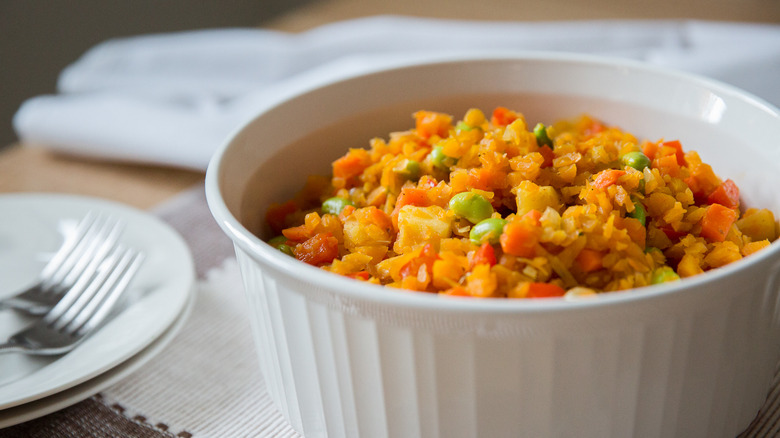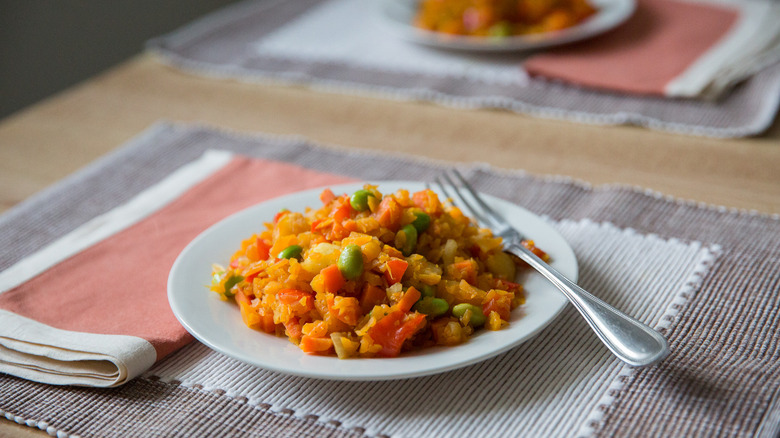Autumnal Butternut Squash Fried "Rice" Recipe
Fried rice is a popular Asian dish made from a mixture of rice, vegetables, perhaps meat or fish, scrambled eggs, and seasonings. It's easy to customize it by mixing up the ingredients according to your preferences, swapping proteins, or changing the vegetables used. Fried rice contains, well, rice, but many creative ways to substitute rice with various vegetables have surfaced in recent years. Ricing cauliflower is probably the most well known.
Butternut squash is yet another vegetable that can be riced with delicious results. Recipe developer Michelle Bottalico brings us a butternut squash "rice" recipe that's perfect for the fall. This is a great substitute for those following a low-carb diet — and for everyone else too, since it's surprisingly delicious. The harmonious blend of flavors from ingredients such as ginger, honey, apple, and edamame, as well as the range of textures from crunchy and soft ingredients, bring satisfaction to every bite. And let's not forget the beautiful rainbow colors this dish will add to your table! If you've been skeptical of classic fried rice alternatives before, we think you may change your mind after giving this nutritious and tasty version a try.
Gather your butternut squash fried rice ingredients
For this recipe, you will first and foremost need a butternut squash. Choose a medium-sized one that is free from too many blemishes, then grab peanut oil for stir-frying. Pick up some fresh ginger for flavor as well as tamari, honey, salt, and pepper. For the other produce ingredients, you'll use carrots, red bell pepper, edamame (the frozen shelled kind for convenience, thawed ahead of time), and whatever kind of apple you prefer.
Step 1: Peel and slice the squash
Carefully peel the butternut squash with a sharp knife and cut into slices, removing the seeds.
Step 2: Cut the squash into chunks
Cut the squash slices into 1-inch chunks.
Step 3: Pulse the butternut squash
Place the squash pieces into a food processor and pulse until the pieces are about as long as grains of rice.
Step 4: Heat the oil
Add oil to a large skillet over medium-high heat. (It's important that the pan is large enough to allow space for extra liquid to evaporate.)
Step 5: Cook the onion and ginger
Add onion and ginger and cook for 2 minutes, stirring occasionally.
Step 6: Cook the vegetables
Add butternut squash, carrot, and bell pepper. Cook for about 8 minutes, stirring frequently.
Step 7: Add the apple and edamame
Stir in the apple and edamame and cook for 2 minutes.
Step 8: Season and finish cooking
Pour in the tamari and honey, season with salt and pepper to taste, stir well, and cook for another 1-2 minutes until the sauce is heated and the extra liquid has evaporated.
Step 9: Serve immediately
Serve immediately.
How can I peel a butternut squash for this butternut squash fried rice recipe?
Including nutritious butternut squash in our diets is a great idea, but the thought of peeling their hard, thick skins may discourage some people from buying them. It's easier to peel a cooked squash, but when the flesh is used raw in recipes like this one, the skin must be removed before cooking.
You may find this isn't too hard with a sharp knife and a little patience. First, cut the lower rounded end off the squash and remove the seeds. Then, slice the squash into inch-long rounds. Place each round flat on a cutting board and vertically slice off the skin around the edges. This method makes it easier and safer to cut the skin off because you're not trying to maneuver a sharp knife or vegetable peeler around a large, rounded surface, and you're not pointing the knife toward your hands.
If you have trouble with the hard skin, try this hack to make peeling a butternut squash easier. Slice off the ends, cut a few slits in the skin, and microwave it for about 3 ½ minutes. The skin will be softer and easier to remove. Lastly, there's always the convenient option of buying riced butternut squash from the freezer section if you prefer it already prepped — just thaw it before you use it.
Can I substitute ingredients when making butternut squash fried rice?
We love this recipe as written, but we also know it can be fun to make substitutions when cooking, or it can be more convenient if you don't have all of the ingredients on hand. Although butternut squash is the star of this dish, you can make other versions of this fried rice by using other kinds of vegetables that can be riced. Cauliflower rice is a popular option that's easy to make by grating the florets, pulsing them in a food processor, or simply cutting thin slices across the florets with a chef's knife.
Many other vegetables can be riced as well, especially firm cruciferous vegetables like broccoli or Brussels sprouts. Firm root vegetables like beets and turnips can be riced too, and don't be afraid to try less conventional options like celery root or jicama. If you want to preserve the orange color of this dish, you can rice sweet potatoes or carrots.

- 1 medium butternut squash
- 1 ½ tablespoons peanut oil
- ½ yellow onion, diced
- 1-inch piece fresh ginger, peeled and minced
- 2 carrots, peeled and diced
- 1 red bell pepper, diced
- 1 large apple, peeled and diced
- ¾ cup shelled edamame, thawed
- ¼ cup tamari
- 1 tablespoon honey
- Salt and black pepper, to taste
- Carefully peel the butternut squash with a sharp knife and cut into slices, removing the seeds.
- Cut the squash slices into 1-inch chunks.
- Place the squash pieces into a food processor and pulse until the pieces are about as long as grains of rice.
- Add oil to a large skillet over medium-high heat. (It's important that the pan is large enough to allow space for extra liquid to evaporate.)
- Add onion and ginger and cook for 2 minutes, stirring occasionally.
- Add butternut squash, carrot, and bell pepper. Cook for about 8 minutes, stirring frequently.
- Stir in the apple and edamame and cook for 2 minutes.
- Pour in the tamari and honey, season with salt and pepper to taste, stir well, and cook for another 1-2 minutes until the sauce is heated and the extra liquid has evaporated.
- Serve immediately.
| Calories per Serving | 149 |
| Total Fat | 4.7 g |
| Saturated Fat | 0.8 g |
| Trans Fat | 0.0 g |
| Cholesterol | 0.0 mg |
| Total Carbohydrates | 25.1 g |
| Dietary Fiber | 5.0 g |
| Total Sugars | 11.5 g |
| Sodium | 691.5 mg |
| Protein | 5.1 g |













